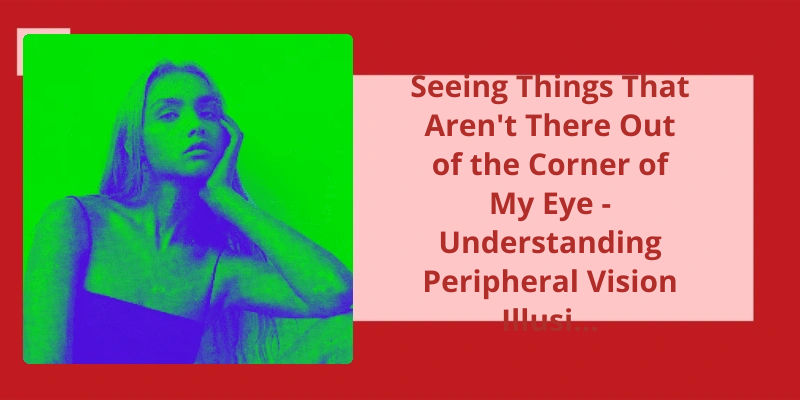Have you ever experienced seeing things that aren't really there, even just out of the corner of your eye? If so, you may have had a visual hallucination. These occurrences can be frightening and cause feelings of stress or anxiety, but they can also be an indicator of a larger underlying issue. It's important to address these experiences with your doctor in order to determine the cause and take steps toward improvement. Though it can feel unsettling, recognizing and seeking help for visual hallucinations is a critical first step in taking control of your health and well-being.
Why Do I Keep Seeing Things in the Corner of My Eye?
It’s thought that these visual disturbances may be attributed to the heightened state of the nervous system during an anxiety attack. When a person is experiencing anxiety, their body is inundated with stress hormones and their senses may become heightened or distorted. This can result in a person perceiving stimuli in a way that they wouldnt under normal circumstances.
Visual irregularities may also be a symptom of certain medical conditions. Eye conditions such as glaucoma and cataracts can cause visual disturbances, as can a migraine headache. Additionally, some medications can cause visual side effects such as blurred vision, double vision or halos around objects. If visual disturbances persist or are accompanied by other symptoms, it’s important to seek medical attention to rule out any underlying medical conditions.
For example, poor lighting conditions or exposure to bright lights, such as those emitted by electronic devices, can cause strain on the eyes and lead to visual disturbances. Additionally, being tired or fatigued can cause the eyes to feel strained and may result in visual irregularities.
It’s important to note that while visual disturbances can be unsettling, they’re generally not something to be overly concerned about.
Finally, it’s worth noting that visual disturbances can also be a result of paranormal or supernatural activity, according to some belief systems. It’s up to individuals to decide whether or not they subscribe to these beliefs, but it’s always important to rule out any medical or psychological causes for visual disturbances before considering other explanations.
How to Differentiate Between Normal Visual Disturbances and Those That May Indicate a More Serious Condition
Visual disturbances can be caused by a variety of factors, including stress, fatigue, and certain medications. However, if visual disturbances occur suddenly or frequently, or if they’re accompanied by other symptoms such as headaches or dizziness, it may be a sign of a more serious condition such as a migraine or a neurological disorder. It’s important to consult a doctor if you’re experiencing persistent or worrisome visual disturbances.
Now that we’ve discussed peripheral vision and it’s role in detecting things outside of your direct line of sight, let’s delve a little deeper into a specific aspect of this type of vision. Did you know that there’s a term used to describe the ability to see things out of the corner of your eye? In this next part of the article, we’ll explore what corner eye vision is and why it’s important.
What Is Corner Eye Vision Called?
Corner eye vision, more commonly known as peripheral vision, is the ability to see objects that are outside your central field of view. This type of vision is essential for your safety and protection as it enables you to detect potential threats or hazards from different angles without having to turn your head. Peripheral vision can be described as an unconscious perception of the environment around you, allowing you to navigate, move and interact with everything that surrounds you.
Your peripheral vision isn’t as clear as your direct line of sight, as the visual acuity decreases as you move away from the central point of focus. However, it covers a much wider area than your straight-ahead vision, providing you with valuable information that you otherwise might not have received. In fact, up to 90% of your visual field is made up of peripheral vision, while only 10% accounts for your central vision.
Many animals, including humans, have a wider field of view than other creatures, which is useful for detecting prey or predators. Predators such as cats have a narrower visual field, which helps them focus on their prey once they spot it. In contrast, herbivores have a wider field of view to detect potential danger from multiple directions. It allows us to be more aware of our surroundings and react accordingly in emergency situations.
How Peripheral Vision Is Affected by Age and Certain Medical Conditions
- Age-related macular degeneration (AMD)
- Glaucoma
- Cataracts
- Diabetic retinopathy
- Retinitis pigmentosa
- Hypertensive retinopathy
- Stargardt disease
- Retinal detachment
- Retinal vein occlusion
- Optic neuritis
- Optic atrophy
- Myopia (nearsightedness)
- Hyperopia (farsightedness)
Source: What Causes Tunnel Vision? Peripheral Vision Loss|Brooklyn
Now that we know what phosphenes are and what causes them, let’s take a closer look at how they affect our perception and what they can reveal about our body and mind.
Why Do I See Pictures When My Eyes Are Closed?
When our eyes are closed, the retina still continues to send signals to the brain, albeit weaker ones. These signals are interpreted by the brain as patterns and shapes, which we see as phosphenes. It’s believed that the phosphene patterns we see are caused due to the firing of different cells in the retina, which then transmit signals to various parts of the brain.
Apart from this, some people also report seeing images or scenes from their dreams when they close their eyes. This phenomenon is called hypnagogic imagery, and it’s believed to occur when the brain is in a transitional state between wakefulness and sleep. During this time, the brain produces spontaneous images, which can sometimes be seen as vivid scenes or patterns.
Phosphenes have also been used in certain medical treatments. For instance, some studies have shown that applying a magnetic field to the brain can cause phosphenes and help treat certain conditions like chronic pain or depression. Similarly, some researchers are exploring the use of phosphenes to help people who’re blind or visually impaired to navigate their surroundings better.
While most floaters are harmless and common, sometimes seeing things out of the corner of your eye can be a sign of something more serious. It’s important to know when to seek medical attention for these symptoms, especially if they appear suddenly or are accompanied by other changes in your vision.
What Does It Mean When You See Things Out of the Corner of Your Eye?
While most floaters are benign, seeing things out of the corner of your eye can also be a sign of more serious eye conditions such as retinal detachment or a torn retina. Retinal detachment occurs when the retina, the tissue that lines the back of the eye and sends visual information to the brain, is pulled away from it’s normal position. This can cause a sudden onset of floaters along with flashes of light in your peripheral vision. Immediate medical attention is necessary to prevent permanent vision loss.
Another condition that can cause peripheral vision disturbances is a migraine with aura. A migraine with aura is a type of headache that’s often preceded by visual disturbances such as seeing flashing lights or zigzag lines in your peripheral vision. While migraine with aura isn’t dangerous, it can be debilitating and affect your quality of life.
In addition to eye conditions, seeing things out of the corner of your eye can be a symptom of neurological conditions such as multiple sclerosis or a brain tumor. Multiple sclerosis is a progressive disease that affects the central nervous system, including the optic nerve. Vision problems such as blurred vision or seeing things out of the corner of your eye can be an early sign of multiple sclerosis.
Other symptoms of a brain tumor include headaches, seizures, and changes in mental function.
If you’re experiencing persistent or worsening peripheral vision disturbances, it’s important to see an eye doctor or medical professional for a comprehensive examination. While most causes are benign, some conditions can be serious and require prompt treatment to prevent permanent vision loss or other complications.
What Are the Most Common Causes of Floaters in the Eye?
Floaters in the eye are caused by small, semi-transparent specks of protein or other material that drift in the vitreous (the clear gel-like substance that fills the inside of the eye). The most common causes of floaters are age-related changes in the vitreous, injury to the eye, and certain medical conditions such as diabetic retinopathy and inflammation in the eye.
Conclusion
In conclusion, visual hallucinations can be a frightening and confusing experience. While it may seem like your mind is playing tricks on you, it's often a sign of an underlying condition that needs to be addressed. Seeking help from a medical professional is essential in understanding the cause and finding solutions to improve your overall well-being. Remember, taking an active role in your health and seeking the appropriate support can lead to a better quality of life.






